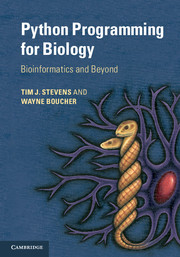Book contents
- Frontmatter
- Contents
- Preface
- Acknowledgements
- 1 Prologue
- 2 A beginners’ guide
- 3 Python basics
- 4 Program control and logic
- 5 Functions
- 6 Files
- 7 Object orientation
- 8 Object data modelling
- 9 Mathematics
- 10 Coding tips
- 11 Biological sequences
- 12 Pairwise sequence alignments
- 13 Multiple-sequence alignments
- 14 Sequence variation and evolution
- 15 Macromolecular structures
- 16 Array data
- 17 High-throughput sequence analyses
- 18 Images
- 19 Signal processing
- 20 Databases
- 21 Probability
- 22 Statistics
- 23 Clustering and discrimination
- 24 Machine learning
- 25 Hard problems
- 26 Graphical interfaces
- 27 Improving speed
- Appendices
- Glossary
- Index
- Plate section
- References
15 - Macromolecular structures
Published online by Cambridge University Press: 05 February 2015
- Frontmatter
- Contents
- Preface
- Acknowledgements
- 1 Prologue
- 2 A beginners’ guide
- 3 Python basics
- 4 Program control and logic
- 5 Functions
- 6 Files
- 7 Object orientation
- 8 Object data modelling
- 9 Mathematics
- 10 Coding tips
- 11 Biological sequences
- 12 Pairwise sequence alignments
- 13 Multiple-sequence alignments
- 14 Sequence variation and evolution
- 15 Macromolecular structures
- 16 Array data
- 17 High-throughput sequence analyses
- 18 Images
- 19 Signal processing
- 20 Databases
- 21 Probability
- 22 Statistics
- 23 Clustering and discrimination
- 24 Machine learning
- 25 Hard problems
- 26 Graphical interfaces
- 27 Improving speed
- Appendices
- Glossary
- Index
- Plate section
- References
Summary
An introduction to 3D structures of bio-molecules
So far in this book the more biological chapters have focussed on sequences: a linear and effectively one-dimensional representation of biological macromolecules. Studying sequences allows us to study the flow of biological information from the genome and how DNA, RNA and protein macromolecules evolve. However, this representation is somewhat removed from the physical reality of the biochemical soup of life, which of course occurs in three-dimensional space. We can even think in terms of four dimensions, if you consider time and how things change. Naturally, change in biological molecules is at the core of all life processes; nothing stands still. Here we will keep things relatively simple, however, and will not delve into the time-dependent, dynamic aspects. Hence, this chapter simply relates to the three-dimensional arrangements of biological molecules.
Here our primary focus is on the structure of proteins and RNA. This is not to say that the structure of DNA is not important, it is of course vital, but the difference is that for proteins (and directly functional, untranslated RNA) our understanding of the way biology works is so much more dependent on a precise three-dimensional structure. DNA, with its double helix, is necessarily an inert and repetitive structure. Things happen to cause deviations from this regularity when DNA is activated and deactivated (for reading), transcribed into mRNA, replicated, repaired etc., but it is the proteins of the cell that are the causal agents for these specific events. The way that proteins interact with DNA is just one of a plethora of different actions they perform to create the life-sustaining processes within organisms. The ability of an organism’s proteins to do a multitude of, usually very precise, jobs stems from the fact that different proteins, encoded in different gene transcripts, have different sequences of amino acid residues. The combinations of amino acids cause the different protein chains, initially made in a linear way, to fold into different three-dimensional structures. It is the precision of the various protein structures, i.e. that the same amino acid sequence virtually always gives the same three-dimensional arrangement of atoms, which allows proteins to perform a task and evolve according to this task, albeit catalysing a chemical reaction, interacting with another biological molecule or whatever.
- Type
- Chapter
- Information
- Python Programming for BiologyBioinformatics and Beyond, pp. 278 - 315Publisher: Cambridge University PressPrint publication year: 2015



